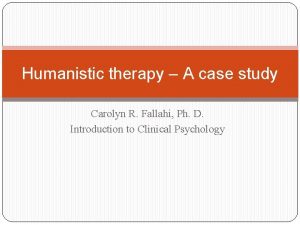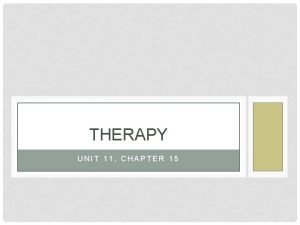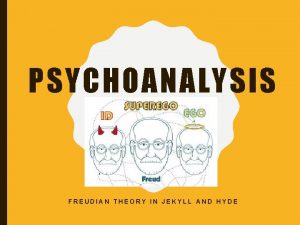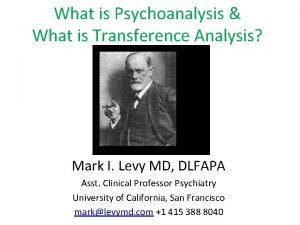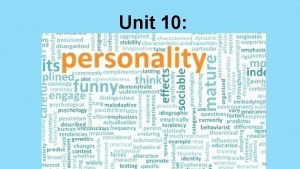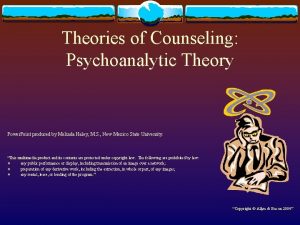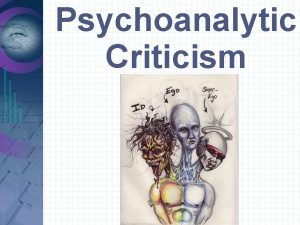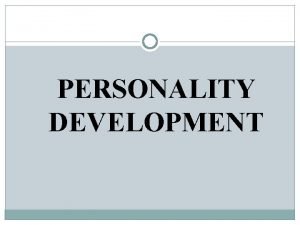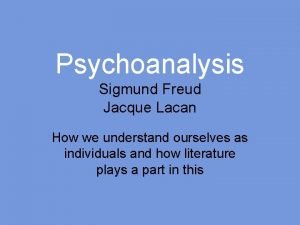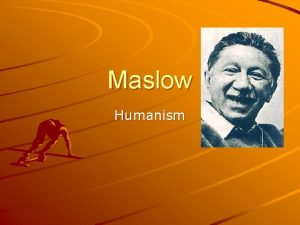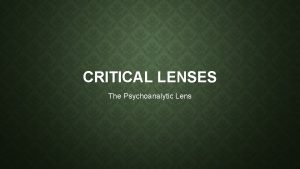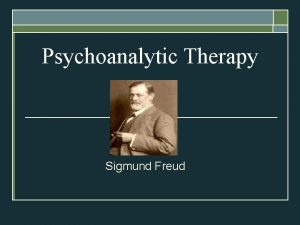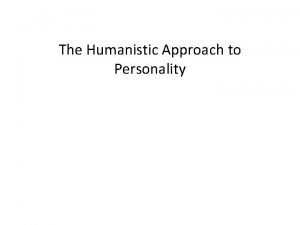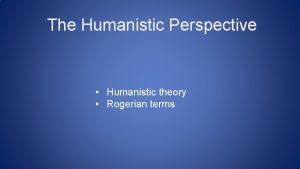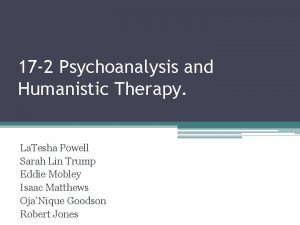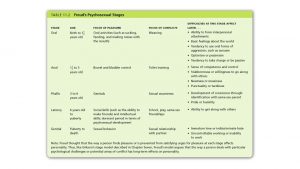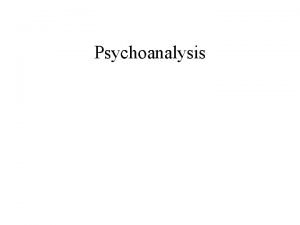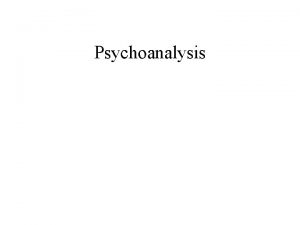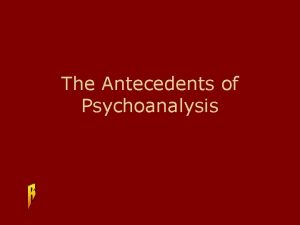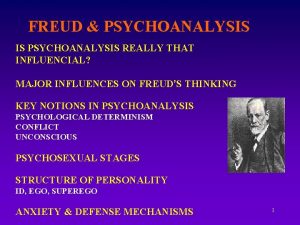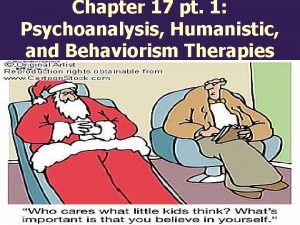PSYCHOANALYSIS AND HUMANISTIC THERAPY Therapy and Change WHAT


















- Slides: 18

PSYCHOANALYSIS AND HUMANISTIC THERAPY Therapy and Change

WHAT DOES THIS DREAM MEAN? I was a child again, and riding my bicycle along the village street, but its wheels began to sink into sticky, muddy earth, so that I could barely move, Finally, however, the earth began to dry, and I found I was able to cycle easily once more.

WHAT DOES THIS DREAM MEAN? Dreamt by an elderly woman fighting a serious illness Psychoanalysts might interpret it this way: earth symbolizes the illness as well as her concern that she might die. As a child, she hadn’t been able to own a bicycle, so having one represented freedom. It symbolized something she badly wanted – good health.

LEARNING INTENTIONS Describe psychoanalysis and its aims Explain Humanistic therapy and its goals.

WHAT IS PSYCHOANALYSIS? For a long time, it was the only formal psychotherapy Based on theories of Sigmund Freud – says psychological disturbances are due to anxiety caused by hidden conflicts among the unconscious components of one’s personality Therapy aimed at making patients aware of their unconscious motives so that they can gain control of their behaviour Gain insight

FREE ASSOCIATION Psychoanalysis is a slow procedure – may take years of sessions to make a breakthrough (average of 600 sessions) Therapist tells patient to relax and talk about everything that comes to mind Called free association Patient may think that some thoughts too passing or embarrassing to mention – encouraged to do so – might offer that insight needed


FREE ASSOCIATION Psychoanalyst may not say anything for a long time – occasionally making remarks or asking questions Patients understandably reluctant to talk about things – very personal – likely will try to unconsciously hold back things, feelings Resistance Can in turn, analyze the resistance to find the source of anxieties

DREAM ANALYSIS Freud – dreams express unconscious thoughts and feelings Dreams contain manifest content (what you remember from your dreams) and latent content (what you don’t actively remember) Considered dreams to be the purest form of free association

TRANSFERENCE Eventually therapist will begin to appear in patient’s associations and dreams – may begin feeling toward therapist the way she feels toward another important figure in their life Transference If the patient is aware what it happening, can help to deal with the emotions Therapist needs to not allow it to happen – need to redirect the feelings back to the patient

To reduce time of psychoanalysis – now there’s short-term dynamic psychotherapy Therapist more direct, focus on problems Not for those who lose touch with reality

HUMANISTIC THERAPY focuses on the value, dignity, and worth of each person Goal is to help people fulfill their potential – client-centered therapy (the client and therapist are partners in therapy) Personal responsibility, freedom of choice, and authentic relationships

CLIENT CENTERED THERAPY Based on theories of Carl Rogers – depends on the clients motivation toward self-growth and self-actualization Uses “client” rather than “patient” because its believed that “patient” refers to passivity or inferiority

CLIENT CENTERED THERAPY Equal relationship between client and therapist – reflects 3 therapeutic components: Positive regard – therapist is caring and has respect for the client Empathy – ability to understand what the client is feeling Genuineness – therapists ability to act toward the client in a real and nondefensive manner

CLIENT CENTERED THERAPY Assumes people are basically good and that they are capable of handling their own lives Problems arise when the true self became lost Need to recognize their own strengths

TECHNIQUES OF CLIENT CENTERED THERAPY Client encouraged to speak freely about any troubling matters, what is discussed is up to the client Nondirective therapy Therapist listens and encourages conversation – tries to avoid giving opinion

TECHNIQUES OF CLIENT CENTERED THERAPY Therapist tries to echo back the feelings of the client Active listening Trying to extract the main points from a client’s hesitant or rambling explanations

TECHNIQUES OF CLIENT CENTERED THERAPY Conducted in an atmosphere of emotional support Unconditional positive regard Therapist never says what he or she thinks of the client or what they have said is good or bad Makes it easier to talk
 Psychodynamic and humanistic therapies have in common
Psychodynamic and humanistic therapies have in common Psychoanalytic therapy is to as humanistic therapy is to
Psychoanalytic therapy is to as humanistic therapy is to Humanistic case conceptualization example
Humanistic case conceptualization example Which drug dampens responsiveness to irrelevant stimuli
Which drug dampens responsiveness to irrelevant stimuli Free association humanistic
Free association humanistic Difference between psychoanalysis and psychodynamic
Difference between psychoanalysis and psychodynamic Freud and jekyll and hyde
Freud and jekyll and hyde The electra complex
The electra complex Transference in psychology
Transference in psychology Psychoanalytic perspective
Psychoanalytic perspective Psychoanalysis
Psychoanalysis Psychoanalysis focuses on
Psychoanalysis focuses on Shrek psychoanalysis
Shrek psychoanalysis Sigmund freud psychoanalysis theory
Sigmund freud psychoanalysis theory Free association
Free association Teoría de lacan
Teoría de lacan Humanism vs psychoanalysis
Humanism vs psychoanalysis Psychoanalytic lense
Psychoanalytic lense Psychoanalytic method
Psychoanalytic method


